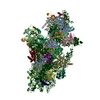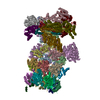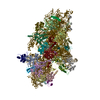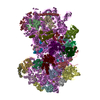+ Open data
Open data
- Basic information
Basic information
| Entry | Database: PDB / ID: 7nfe | ||||||
|---|---|---|---|---|---|---|---|
| Title | Cryo-EM structure of NHEJ super-complex (monomer) | ||||||
 Components Components |
| ||||||
 Keywords Keywords | DNA BINDING PROTEIN / NHEJ / DNA-PKcs / Ku70/80 / XLF / XRCC4 / DNA-LigaseIV | ||||||
| Function / homology |  Function and homology information Function and homology informationFHA domain binding / positive regulation of chromosome organization / positive regulation of ligase activity / DNA ligase IV complex / positive regulation of platelet formation / DNA ligase activity / Ku70:Ku80 complex / DN2 thymocyte differentiation / negative regulation of t-circle formation / T cell receptor V(D)J recombination ...FHA domain binding / positive regulation of chromosome organization / positive regulation of ligase activity / DNA ligase IV complex / positive regulation of platelet formation / DNA ligase activity / Ku70:Ku80 complex / DN2 thymocyte differentiation / negative regulation of t-circle formation / T cell receptor V(D)J recombination / DNA ligase (ATP) / DNA end binding / pro-B cell differentiation / small-subunit processome assembly / DNA-dependent protein kinase activity / positive regulation of lymphocyte differentiation / DNA ligase (ATP) activity / DNA-dependent protein kinase complex / histone H2AXS139 kinase activity / DNA-dependent protein kinase-DNA ligase 4 complex / immunoglobulin V(D)J recombination / nonhomologous end joining complex / nucleotide-excision repair, DNA gap filling / immature B cell differentiation / single strand break repair / regulation of smooth muscle cell proliferation / cellular response to X-ray / V(D)J recombination / regulation of epithelial cell proliferation / double-strand break repair via alternative nonhomologous end joining / double-strand break repair via classical nonhomologous end joining / nuclear telomere cap complex / isotype switching / Cytosolic sensors of pathogen-associated DNA / protein localization to site of double-strand break / telomere capping / IRF3-mediated induction of type I IFN / regulation of hematopoietic stem cell differentiation / positive regulation of neurogenesis / recombinational repair / regulation of telomere maintenance / protein localization to chromosome, telomeric region / U3 snoRNA binding / DNA biosynthetic process / maturation of 5.8S rRNA / T cell lineage commitment / cellular response to lithium ion / cellular hyperosmotic salinity response / negative regulation of cGAS/STING signaling pathway / response to ionizing radiation / positive regulation of double-strand break repair via nonhomologous end joining / B cell lineage commitment / 2-LTR circle formation / hematopoietic stem cell proliferation / ligase activity / telomeric DNA binding / negative regulation of protein phosphorylation / positive regulation of protein kinase activity / Lyases; Carbon-oxygen lyases; Other carbon-oxygen lyases / site of DNA damage / peptidyl-threonine phosphorylation / T cell differentiation / 5'-deoxyribose-5-phosphate lyase activity / somatic stem cell population maintenance / hematopoietic stem cell differentiation / response to X-ray / chromosome organization / ATP-dependent activity, acting on DNA / somitogenesis / ectopic germ cell programmed cell death / telomere maintenance via telomerase / SUMOylation of DNA damage response and repair proteins / condensed chromosome / DNA polymerase binding / mitotic G1 DNA damage checkpoint signaling / neurogenesis / DNA helicase activity / activation of innate immune response / telomere maintenance / positive regulation of erythrocyte differentiation / cyclin binding / B cell differentiation / central nervous system development / cellular response to leukemia inhibitory factor / positive regulation of translation / stem cell proliferation / response to gamma radiation / cellular response to ionizing radiation / Nonhomologous End-Joining (NHEJ) / small-subunit processome / enzyme activator activity / cellular response to gamma radiation / protein-DNA complex / regulation of circadian rhythm / brain development / peptidyl-serine phosphorylation / base-excision repair / protein destabilization / protein modification process / double-strand break repair via nonhomologous end joining Similarity search - Function | ||||||
| Biological species |  Homo sapiens (human) Homo sapiens (human) | ||||||
| Method | ELECTRON MICROSCOPY / single particle reconstruction / cryo EM / Resolution: 4.29 Å | ||||||
 Authors Authors | Chaplin, A.K. / Hardwick, S.W. / Kefala Stavridi, A. / Chirgadze, D.Y. / Blundell, T.L. | ||||||
| Funding support |  United Kingdom, 1items United Kingdom, 1items
| ||||||
 Citation Citation |  Journal: Mol Cell / Year: 2021 Journal: Mol Cell / Year: 2021Title: Cryo-EM of NHEJ supercomplexes provides insights into DNA repair. Authors: Amanda K Chaplin / Steven W Hardwick / Antonia Kefala Stavridi / Christopher J Buehl / Noah J Goff / Virginie Ropars / Shikang Liang / Taiana Maia De Oliveira / Dimitri Y Chirgadze / ...Authors: Amanda K Chaplin / Steven W Hardwick / Antonia Kefala Stavridi / Christopher J Buehl / Noah J Goff / Virginie Ropars / Shikang Liang / Taiana Maia De Oliveira / Dimitri Y Chirgadze / Katheryn Meek / Jean-Baptiste Charbonnier / Tom L Blundell /    Abstract: Non-homologous end joining (NHEJ) is one of two critical mechanisms utilized in humans to repair DNA double-strand breaks (DSBs). Unrepaired or incorrect repair of DSBs can lead to apoptosis or ...Non-homologous end joining (NHEJ) is one of two critical mechanisms utilized in humans to repair DNA double-strand breaks (DSBs). Unrepaired or incorrect repair of DSBs can lead to apoptosis or cancer. NHEJ involves several proteins, including the Ku70/80 heterodimer, DNA-dependent protein kinase catalytic subunit (DNA-PKcs), X-ray cross-complementing protein 4 (XRCC4), XRCC4-like factor (XLF), and ligase IV. These core proteins bind DSBs and ligate the damaged DNA ends. However, details of the structural assembly of these proteins remain unclear. Here, we present cryo-EM structures of NHEJ supercomplexes that are composed of these core proteins and DNA, revealing the detailed structural architecture of this assembly. We describe monomeric and dimeric forms of this supercomplex and also propose the existence of alternate dimeric forms of long-range synaptic complexes. Finally, we show that mutational disruption of several structural features within these NHEJ complexes negatively affects DNA repair. | ||||||
| History |
|
- Structure visualization
Structure visualization
| Movie |
 Movie viewer Movie viewer |
|---|---|
| Structure viewer | Molecule:  Molmil Molmil Jmol/JSmol Jmol/JSmol |
- Downloads & links
Downloads & links
- Download
Download
| PDBx/mmCIF format |  7nfe.cif.gz 7nfe.cif.gz | 1 MB | Display |  PDBx/mmCIF format PDBx/mmCIF format |
|---|---|---|---|---|
| PDB format |  pdb7nfe.ent.gz pdb7nfe.ent.gz | 808.7 KB | Display |  PDB format PDB format |
| PDBx/mmJSON format |  7nfe.json.gz 7nfe.json.gz | Tree view |  PDBx/mmJSON format PDBx/mmJSON format | |
| Others |  Other downloads Other downloads |
-Validation report
| Summary document |  7nfe_validation.pdf.gz 7nfe_validation.pdf.gz | 1.6 MB | Display |  wwPDB validaton report wwPDB validaton report |
|---|---|---|---|---|
| Full document |  7nfe_full_validation.pdf.gz 7nfe_full_validation.pdf.gz | 1.7 MB | Display | |
| Data in XML |  7nfe_validation.xml.gz 7nfe_validation.xml.gz | 160.4 KB | Display | |
| Data in CIF |  7nfe_validation.cif.gz 7nfe_validation.cif.gz | 244.5 KB | Display | |
| Arichive directory |  https://data.pdbj.org/pub/pdb/validation_reports/nf/7nfe https://data.pdbj.org/pub/pdb/validation_reports/nf/7nfe ftp://data.pdbj.org/pub/pdb/validation_reports/nf/7nfe ftp://data.pdbj.org/pub/pdb/validation_reports/nf/7nfe | HTTPS FTP |
-Related structure data
| Related structure data |  12301MC  7nfcC M: map data used to model this data C: citing same article ( |
|---|---|
| Similar structure data |
- Links
Links
- Assembly
Assembly
| Deposited unit | 
|
|---|---|
| 1 |
|
- Components
Components
-Protein , 4 types, 6 molecules AFGHIJ
| #1: Protein | Mass: 472056.281 Da / Num. of mol.: 1 / Source method: isolated from a natural source / Source: (natural)  Homo sapiens (human) / Cell line: HELA Homo sapiens (human) / Cell line: HELAReferences: UniProt: P78527, non-specific serine/threonine protein kinase | ||||
|---|---|---|---|---|---|
| #4: Protein | Mass: 33372.234 Da / Num. of mol.: 2 Source method: isolated from a genetically manipulated source Source: (gene. exp.)  Homo sapiens (human) / Gene: NHEJ1, XLF / Production host: Homo sapiens (human) / Gene: NHEJ1, XLF / Production host:  #5: Protein | Mass: 38337.703 Da / Num. of mol.: 2 Source method: isolated from a genetically manipulated source Source: (gene. exp.)  Homo sapiens (human) / Gene: XRCC4 / Production host: Homo sapiens (human) / Gene: XRCC4 / Production host:  #6: Protein | | Mass: 104124.953 Da / Num. of mol.: 1 Source method: isolated from a genetically manipulated source Source: (gene. exp.)  Homo sapiens (human) / Gene: LIG4 / Production host: Homo sapiens (human) / Gene: LIG4 / Production host:  |
-X-ray repair cross-complementing protein ... , 2 types, 2 molecules BC
| #2: Protein | Mass: 69945.039 Da / Num. of mol.: 1 Source method: isolated from a genetically manipulated source Source: (gene. exp.)  Homo sapiens (human) / Gene: XRCC6, G22P1 Homo sapiens (human) / Gene: XRCC6, G22P1Production host: Insect cell expression vector pTIE1 (others) References: UniProt: P12956, Hydrolases; Acting on acid anhydrides; Acting on acid anhydrides to facilitate cellular and subcellular movement, Lyases; Carbon-oxygen lyases; Other carbon-oxygen lyases |
|---|---|
| #3: Protein | Mass: 82812.438 Da / Num. of mol.: 1 Source method: isolated from a genetically manipulated source Source: (gene. exp.)  Homo sapiens (human) / Gene: XRCC5, G22P2 Homo sapiens (human) / Gene: XRCC5, G22P2Production host: Insect cell expression vector pTIE1 (others) References: UniProt: P13010, Hydrolases; Acting on acid anhydrides; Acting on acid anhydrides to facilitate cellular and subcellular movement |
-DNA chain , 2 types, 2 molecules DE
| #7: DNA chain | Mass: 7367.843 Da / Num. of mol.: 1 / Source method: obtained synthetically / Source: (synth.)  Homo sapiens (human) Homo sapiens (human) |
|---|---|
| #8: DNA chain | Mass: 7402.821 Da / Num. of mol.: 1 / Source method: obtained synthetically / Source: (synth.)  Homo sapiens (human) Homo sapiens (human) |
-Experimental details
-Experiment
| Experiment | Method: ELECTRON MICROSCOPY |
|---|---|
| EM experiment | Aggregation state: PARTICLE / 3D reconstruction method: single particle reconstruction |
- Sample preparation
Sample preparation
| Component |
| ||||||||||||||||||||||||||||||||||||
|---|---|---|---|---|---|---|---|---|---|---|---|---|---|---|---|---|---|---|---|---|---|---|---|---|---|---|---|---|---|---|---|---|---|---|---|---|---|
| Molecular weight | Value: 0.8 MDa / Experimental value: NO | ||||||||||||||||||||||||||||||||||||
| Source (natural) |
| ||||||||||||||||||||||||||||||||||||
| Source (recombinant) |
| ||||||||||||||||||||||||||||||||||||
| Buffer solution | pH: 7.4 | ||||||||||||||||||||||||||||||||||||
| Specimen | Conc.: 3 mg/ml / Embedding applied: NO / Shadowing applied: NO / Staining applied: NO / Vitrification applied: YES | ||||||||||||||||||||||||||||||||||||
| Vitrification | Cryogen name: ETHANE |
- Electron microscopy imaging
Electron microscopy imaging
| Experimental equipment |  Model: Titan Krios / Image courtesy: FEI Company |
|---|---|
| Microscopy | Model: FEI TITAN KRIOS |
| Electron gun | Electron source:  FIELD EMISSION GUN / Accelerating voltage: 300 kV / Illumination mode: FLOOD BEAM FIELD EMISSION GUN / Accelerating voltage: 300 kV / Illumination mode: FLOOD BEAM |
| Electron lens | Mode: BRIGHT FIELD / Nominal magnification: 130000 X / Cs: 2.7 mm / C2 aperture diameter: 50 µm |
| Specimen holder | Cryogen: NITROGEN / Specimen holder model: FEI TITAN KRIOS AUTOGRID HOLDER |
| Image recording | Average exposure time: 1.3 sec. / Electron dose: 46.8 e/Å2 / Film or detector model: GATAN K3 BIOQUANTUM (6k x 4k) |
- Processing
Processing
| Software |
| ||||||||||||||||||||||||
|---|---|---|---|---|---|---|---|---|---|---|---|---|---|---|---|---|---|---|---|---|---|---|---|---|---|
| EM software |
| ||||||||||||||||||||||||
| CTF correction | Type: PHASE FLIPPING AND AMPLITUDE CORRECTION | ||||||||||||||||||||||||
| Particle selection | Num. of particles selected: 749185 | ||||||||||||||||||||||||
| Symmetry | Point symmetry: C1 (asymmetric) | ||||||||||||||||||||||||
| 3D reconstruction | Resolution: 4.29 Å / Resolution method: FSC 0.143 CUT-OFF / Num. of particles: 45943 / Symmetry type: POINT | ||||||||||||||||||||||||
| Refinement | Cross valid method: NONE Stereochemistry target values: GeoStd + Monomer Library + CDL v1.2 | ||||||||||||||||||||||||
| Displacement parameters | Biso mean: 358.24 Å2 | ||||||||||||||||||||||||
| Refine LS restraints |
|
 Movie
Movie Controller
Controller












 PDBj
PDBj













































